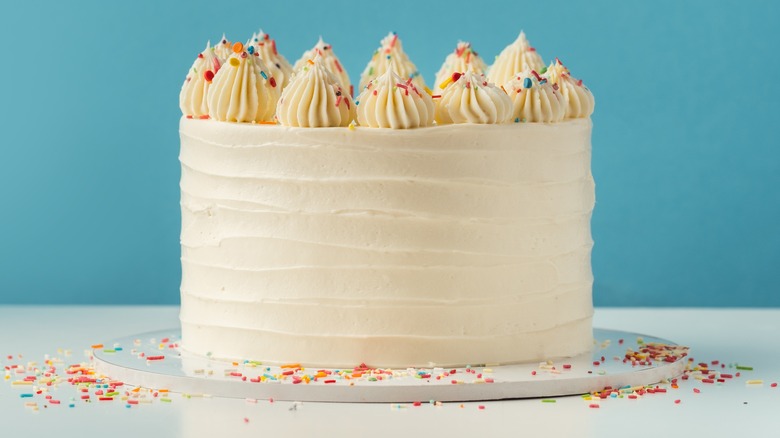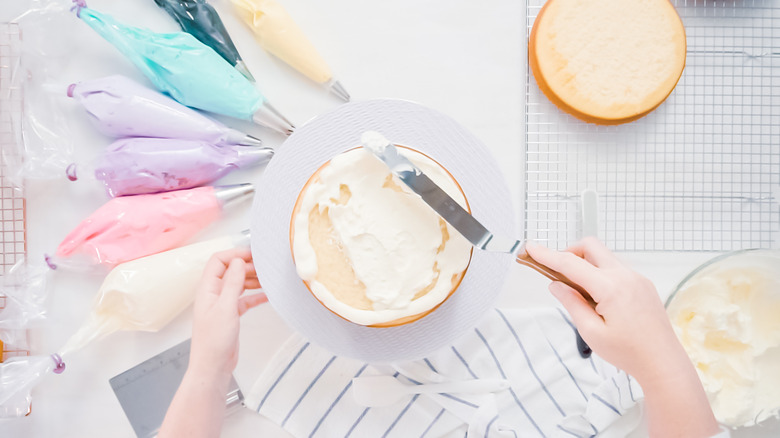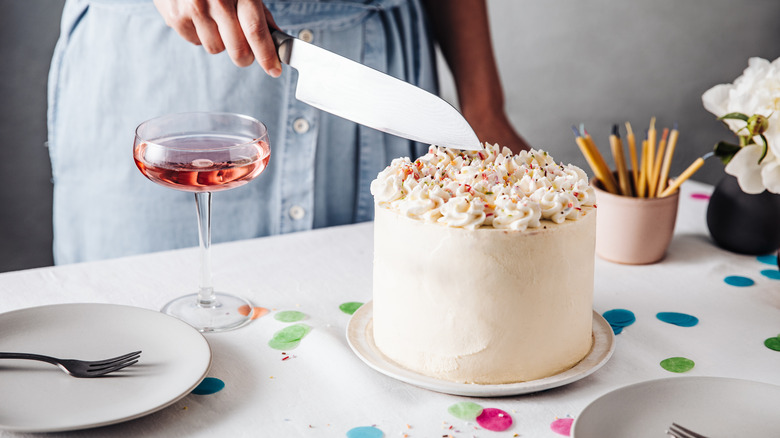Why Buttercream Frosting And Royal Icing Can Be A Bad Combo For Cake Decorating
Cakes, like many baked goods, are fickle things. If one little ingredient is off, all your hard work can take the fall. The same goes for the decorations on top. Luckily, some blunders are just as easy to avoid as they are to make.
The next time you bust out the piping bag, one major rule to keep in mind is not to mix royal icing and buttercream. When combined, the latter can break down the former, resulting in melty, less-than-precise designs. The kind of buttercream commonly used for cakes, also known as American buttercream, is made from a base of butter, confectioner's sugar, heavy cream, and vanilla mixed into a rich and fluffy frosting. Its fat content is what makes it so delicious, but it's also what causes fat-free royal icing — typically made from beaten egg whites and confectioner's sugar — to bleed all over your cake.
While it's ultimately the taste that matters, it's always rewarding to make bakery-worthy confections at home. On that note, here's how to choose between buttercream and royal icing for your next cake-decorating project.
Avoid a mess
As long as you don't combine them, royal icing and buttercream are both excellent options for decorating a cake. Choosing between the two all depends on what kind of look you're going for.
For super-detailed designs with a hardened, glossy finish, reach for royal icing. Its thinner texture is ideal for crafting intricate shapes and letters, which is why it's so commonly used to decorate baked goods with small surface areas, such as sugar cookies.
Meanwhile, buttercream yields a fluffy, cloud-like texture that sets in the fridge without losing its matte finish. It's also a great option when you don't feel like piping; just spread a generous amount on top of your cake and make delicate swooping motions with the back of a spoon, as you would with whipped cream, to create a perfectly imperfect wave-like effect. If you do plan to pipe your buttercream, letting it sit in the freezer for a few minutes will make it easier to work with.
Taste test
Another important factor to consider when choosing between buttercream and royal icing is the taste. It might sound obvious, but it's easy to overlook when pipette flowers are involved.
Buttercream is typically thought of as the more palatable option thanks to the holy combination of butter, cream, sugar, and vanilla. The heavenly aroma of softened butter binding with sugar might be the baking equivalent of garlic and onions sauteeing in butter.
If you're willing to make concessions on richness in service of an impeccably decorated cake, royal icing will do just fine — unless, of course, you're the Reddit user who wrote, "[royal icing] looks nice but I personally hate it." While royal icing might get a bad rap from certain baked-good enthusiasts for its relative lack of flavor in comparison to buttercream, it's easy to liven up. Try adding a bit of citrus zest, and don't skip the vanilla extract.


